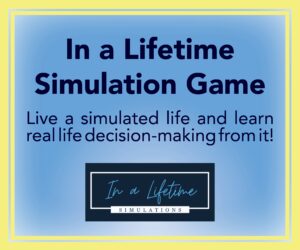Your new client, Lucy, has come to see you about her issues with maintaining long-lasting and healthy relationships. Lucy shares that she has never felt safe in any relationship and fears her partner will leave her. She constantly worries about being abandoned by the people she loves and often uses sex as a way to “reconnect” with romantic interests. With little success, Lucy frequently engages in poor communication tactics and maladaptive behaviors with her current partner and requires constant affirmation to feel safe, seen, and loved. When she does not receive continuous affirmation and reassurance, she fears abandonment.
You ask Lucy about her upbringing, and she hesitantly shares that her mother and father were rarely present. You uncover that Lucy’s parents did not meet her needs as a child. When Lucy was upset, her parents turned her away, forcing her to self-soothe. Her unstable relationship with her often-absent parents influenced her development of an anxious-attachment style.
Attachment to caregivers
In many cases, the attachment we form to our primary caregivers during infancy dictates our future attachment styles. As marriage and family therapists (MFT), we must ask questions to understand our client’s relationship with their parental figures, as early bonds with parental figures will likely strongly affect the relationships they form in adulthood. Like Lucy’s story, The Attachment Project (2024) explains that an anxious or ambivalent attachment style begins during infancy and occurs when the primary caregiver fails to meet the child’s needs. Alhusen et al. (2013) explain that when the primary caregivers do not act in nurturing or protective ways that make the infant feel secure, the child’s social, emotional, and cognitive development will be negatively affected. Alhusen et al. (2013) even found that attachment passed down from parent to child can continue across generations if unresolved. Parents and expectant parents should learn their own attachment styles, to ensure that they do not unknowingly pass down an insecure attachment style.
Clients may be unaware of early attachments and the possible adverse effects on adult relationships. Unhealthy (insecure) attachments formed from one’s relationship with primary caregivers during infancy/childhood have the potential to shape the quality of future relationships. Insecure attachments can lead to unstable relationships, unhealthy communication styles and behaviors, negative self-perceptions, and other damaging issues. Hazan and Shaver (1987) found that an insecure attachment during infancy led to negative traits such as fear of intimacy, jealousy, and loneliness in adulthood. MFTs must discuss with clients how their relationships with primary caregivers can significantly influence their attachment styles and future relationship satisfaction.
Behaviors found in insecure attachment styles:
- A general lack of trust in their partner
- The use of restrictive engulfment and controlling behaviors
- Feelings of un-lovability
- Concerns of abandonment or rejection
See your personal attachment style here: https://quiz.attachmentproject.com/
Therapists must assess the common behaviors found in individuals with insecure attachment styles. It is typical for insecurely attached individuals to exhibit all, or some, of the traits listed above, and it is the therapist’s responsibility to ask the necessary questions that may uncover the presence of an insecure attachment style.
A study conducted by Areseneault et al. (2023) uncovered a correlation between insecure attachment styles and the use of coercion and control, which led to increased partner violence.
Toplu-Demirtaş et al., 2019 uncovered that anxiously-attached individuals were likelier to use restrictive engulfment with their partner, defined as engaging in acts intended to isolate, limit, and control their partners’ social circle. Therapists must ask questions to understand the client’s romantic relationship dynamics and assess if patterns of restrictive engulfment are present. If patterns of restrictive engulfment appear to be present in the client’s relationship, the therapist must assess for signs of domestic violence. A study conducted by Areseneault et al. (2023) uncovered a correlation between insecure attachment styles and the use of coercion and control, which led to increased partner violence.
Similarly, Nascimento et al. (2022) uncovered that individuals with anxious attachment styles are more likely to perceive less trust and support overall in their romantic relationships. Patterns correlated to concerns of abandonment, rejection, and feeling unlovable are also common for anxious attachment styles (Julal et al., 2019). As Lucy’s therapist, it is evident that she fears that the people closest to her will soon abandon her, which causes her heightened levels of anxiety.
Therapeutic solutions
MFTs can guide insecurely-attached clients like Lucy by implementing therapeutic interventions and techniques into their practices. Attachment theory is not a fixed character trait, meaning that individuals with insecure attachment styles can change how they connect with people and form relationships. When individuals gain new relational experiences, their cognitive working models of attachment and emotional regulation strategies can be changed (Davila et al., 1999).
So, how can we, as MFTs, help our clients reframe their attachment style from insecure to secure? The answer lies within Emotion Focused Therapy (EFT). EFT focuses on regulating one’s emotions to help promote change, growth, and overall healing. By doing so, EFT inevitably promotes the creation of healthy, secure relationships. EFT helps the client focus on dealing with their emotions, allowing them to improve personal relationships.
 Attachment Theory in Practice by Dr. Susan Johnson explains that Emotion-Focused Therapy and Bowlby’s Attachment Theory go hand-in-hand. Johnson (2019) points out that EFT incorporates the main points of Attachment Theory while providing evidence-backed techniques that facilitate the healing of an insecure attachment style.
Attachment Theory in Practice by Dr. Susan Johnson explains that Emotion-Focused Therapy and Bowlby’s Attachment Theory go hand-in-hand. Johnson (2019) points out that EFT incorporates the main points of Attachment Theory while providing evidence-backed techniques that facilitate the healing of an insecure attachment style.
How are Emotion Focused Therapy and Attachment Theory connected?
- EFT gives individuals the tools to express their emotional needs in the context of their relationship, thus promoting a more secure attachment.
- EFT teaches individuals with insecure attachments to regulate their emotions, something they likely struggled with as a child.
- The therapeutic bond between the therapist and client allows for a secure attachment to form, promoting the formation of other healthy relationships in the client’s personal life.
Solution to story and solution to the problem as a whole:
MFTs must emphasize that insecurely attached individuals can form secure attachments by acknowledging and practicing healthy communication skills. Therefore, Lucy can be comforted that despite her anxious tendencies, she can eventually develop a secure attachment style. Stanton et al. (2017) explain that positive relationship experiences can aid in altering insecure attachment styles through perception and behavioral changes and can decrease attachment insecurity over time.
In Lucy’s case, it may be beneficial to suggest certain reflective activities to help her develop a more secure attachment style. Lucy’s disclosure of her attachment style to her partner would aid in her feelings of security. Stanton et al. (2017) suggest that individuals with insecure attachments engage in intimacy-focused activities with their partners. This study also revealed that strong communication and accommodating behaviors from the non-insecure partner can aid in shifting an insecure attachment. MFTs would benefit from bringing both partners in for a session, if the client is willing, in order to educate the client’s partner on how to support them best. By creating a safe therapeutic space for clients like Lucy to process their fears and develop new relational skills, MFTs play a vital role in providing clients with the tools and knowledge necessary to break free from the cycle of insecure attachment and discover the joy of secure, healthy love.


Julie Payne, DMFT, LMFT, is an AAMFT Professional member holding the Clinical Fellow and Approved Supervisor designations and a Clinical Assistant Professor at Chapman University in the Marriage and Family Therapy Program. She has over 17 years of clinical experience working in community-based mental health and private practice settings. Dr. Payne is currently licensed and practicing in California and Texas specializing in working with families and individuals living with chronic illness/pain, military families, children and adolescents, and trauma.

Nicole Chamorro, is a first-year MFT graduate student at Chapman University. Chamorro hopes to work with young women and adolescents who struggle with forming healthy relationships. In her future work, she wants to help her clients understand their own attachment styles, and how to use this knowledge to form stronger and more meaningful connections.

Valeria Castillo, is a first-year graduate student at Chapman University. Her interests are working with adolescents and young adults. More specifically, the Latinx population and relationship/family dynamics, which is the reason that attachment styles peaked her interest. From her personal life, she has become passionate about improving maladaptive behaviors within family dynamics because she witnessed how it has benefitted her own relationships.
Alhusen, J.L., Hayat, M.J. & Gross, D. A longitudinal study of maternal attachment and infant developmental outcomes. Arch Womens Ment Health 16, 521–529 (2013). https://doi.org/10.1007/s00737-013-0357-8
Arseneault, L., Lefebvre, A.-A., Lafontaine, M.-F., Godbout, N., Daspe, M.-E., Savard, C., & Peloquin, K. (2023, July 14). Romantic Attachment and Intimate Partner Violence Perpetrated by Individuals Seeking Help: The Roles of Dysfunctional Communication Patterns and Relationship Satisfaction. Springer Link. https://link-springer-com.chapman.idm.oclc.org/article/10.1007/s10896-023-00600-z
Davila, J., Karney, B. R., & Bradbury, T. N. (1999). Attachment change processes in the early years of marriage. Journal of Personality and Social Psychology, 76(5), 783–802. https://doi.org/10.1037//0022-3514.76.5.783
Johnson, S. M. (2019). Attachment theory in practice: Emotionally focused therapy (EFT) with individuals, couples, and families (Vol. 1). The Guilford Press.
Gordon, Jock. (2024). Attachment style test: The Attachment Project. https://quiz.attachmentproject.com/
Hazan, C., & Shaver, P. (1987). Romantic love conceptualized as an attachment process. Journal of Personality and Social Psychology, 52(3), 511–524.
Julal Cnossen, F. S., Harman, K. A., & Butterworth, R. (2019). Attachment, efficacy beliefs and relationship satisfaction in dating, emerging adult women. Journal of Relationships Research, 10. https://doi-org.chapman.idm.oclc.org/10.1017/jrr.2019.14
Nascimento, B. S., Little, A. C., Monteiro, R. P., Hanel, P. H. P., & Vione, K. C. (2022). Attachment styles and mate-retention: Exploring the mediating role of relationship satisfaction. Evolutionary Behavioral Sciences, 16(4), 362–370. https://doi-org.chapman.idm.oclc.org/10.1037/ebs0000272
Stanton, S. C. E., Campbell, L., & Pink, J. C. (2017). Benefits of positive relationship experiences for avoidantly attached individuals. Journal of Personality and Social Psychology, 113(4), 568–588. https://doi.org/10.1037/pspi0000098
Toplu-Demirtaş, E., Murray, C., & Hatipoglu-Sümer, Z. (2019). Attachment insecurity and restrictive engulfment in college student relationships: the mediating role of relationship satisfaction. [Attachment insecurity and RE] Journal of Aggression, Conflict and Peace Research, 11(1), 24-37. https://doi.org/10.1108/JACPR-11-2017-0333
Other articles
Breaking the Stigma Surrounding Male Infertility
You’ve been seeing a couple for several months when they mention their struggles with trying to conceive. As they open up, it becomes clear that they’ve been attempting to conceive naturally for over a year without success. Their doctor has recommended standard fertility testing for both partners. The woman, age 32, shares that she has been feeling discouraged, expressing her desire to become a mother. However, her husband, age 34, appears detached and offers minimal input.
Julie Payne, DMFT, & Bonnie R. Chiu
Bridging the Gap between ABA and the MFT Field in Supporting Minority Families
As a marriage and family therapist (MFT), one can encounter a family with an autistic child who utilizes Applied Behavioral Analysis (ABA) therapy. The system’s inflexibility makes it difficult for parents to navigate and integrate into their busy lives while attending to the demands of parenting a child with autism. Additionally, cultural barriers can leave the family disheartened and feeling lost or unsupported while trying to navigate the process of ABA services.
Megan Felix, Julie Payne, DMFT, & Anna Forslund
How Technoference Breaks Down Families: What MFTs Need to Know
Digital media and modern technology have become a part of people’s everyday lives through useful applications in work, school, communication, etc. However, research finds that it has created an interpersonal wall during shared child-parent activities known as technology interference (technoference) which negatively impacts the child-parent relationship.
Julie Payne, DMFT, David Jimenez, & Kimberly Licona





